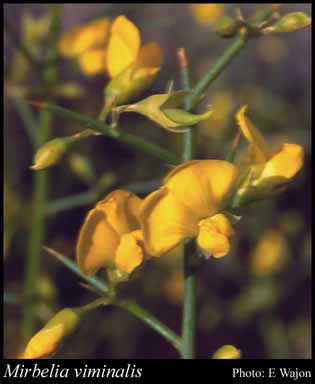- Reference
- Enum.Pl.Austral.Occ. 57 (1930)
- Conservation Code
- Not threatened
- Naturalised Status
- Native to Western Australia
- Name Status
- Current
Erect to spreading, much-branched, spiny shrub, 0.4-2 m high. Fl. yellow, Mar to Oct. Sand, sandstone, stony loam. Rocky outcrops, screes, plateaus, hills.

Scientific Description
Genus Mirbelia. Form prostrate,spreading or scrambling. Habit shrub, spindly shrub (broom-like). Stems Indumentum glabrous, Pustules or glands absent, Striation (stems ribbed) striate, Cross section terete, Spiny on any part of plant spiny at least in part. Leaves or phylloclades Presence clearly present, Position alternate, Leaves simple (?) or compound (?), Leaves or phylloclade continuous with stem continuous with stem, Cross section of leaf or leaflet terete (?), flat with flat margins (?), flat with recurved margins (?), flat with incurved margins (conduplicate) (?), strongly recurved, appearing terete but with one or two grooves below (?), strongly incurved, appearing terete but grooved above (?) or revolute (?), Margins of leaf or leaflet entire, Tuberculate tubercles absent, Pustules or glands absent. Length Leaf length 15-45. Width (entire leaves only) Leaf width 1-1.5. Scale leaves length mm long NaN (?). Indumentum Presence glabrous, Type simple (?) or gland-tipped (?). Stipules Presence present but early deciduous ( only visible on youngest leaves ), Glands with glands (?) or without glands (?), Ribs ribbed (?) or ribless (?). Length Stipule length NaN (?). Bracteoles Presence present and persistent, Indumentum hairy (?) or glabrous (?), Striation striate (?) or not striate (?). Length Bracteole length NaN (?). Pedicel Presence present, Indumentum hairy. Length Pedicel length 3-4. Calyx Pustules or glands absent, Ribs ribless, Enlarged in fruit not accrescent. Length Calyx length 4-6. Indumentum Presence hairy, Type with simple hairs. Corolla Colour patterning uniformly coloured, Colour (when uniformly coloured) yellow, Petal claws ( the narrow base of the petals absent. Length Corolla length 8-11. Indumentum Presence absent. Standard Indumentum glabrous, Auricles not auriculate. Length Standard length 6-9. Wings Auricles not auriculate. Length Wing length 5.6-8.5. Keel Auricles not auriculate, Indumentum glabrous, Beak not beaked. Length Keel length 5.6-7.3. Stamens Number ten. Anthers anther length 0.6-0.7, Position at two different levels (filaments alternately long and short). Filaments Fusion free (or united at the very base). Length Filament length 3-5. Ovary Placement stipitate. Indumentum Presence glabrous. Style Indumentum glabrous, Bearded ( with a tuft of hairs at apex ) not bearded, Apex terete. Length Style length 3.6-5. Fruit Type dehiscent (a pod or follicle), Constriction not constricted between the seeds, Compression round in cross-section, Placement stipitate, Beak not beaked. Length Fruit length NaN (?). Width Fruit width NaN (?). Indumentum Presence hairy (?) or glabrous (?), Indumentum type with simple hairs (?) or with glandular hairs (?). Flowering time March, April, May, June, July, August, September or October. Distribution Botanical Province Northern or Eremaean, IBRA Bioregion Great Sandy Desert, Pilbara, Carnarvon, Central Ranges, Northern Kimberley, Victoria Bonaparte, Central Kimberley, Ord-Victorian-Plain, Tanami or Dampierland.
Distribution
- IBRA Regions
- Carnarvon, Central Kimberley, Central Ranges, Dampierland, Great Sandy Desert, Little Sandy Desert, Northern Kimberley, Ord Victoria Plain, Pilbara, Tanami, Victoria Bonaparte.
- IBRA Subregions
- Berkeley, Cape Range, Chichester, Fortescue, Hamersley, Keep, Mackay, Mann-Musgrave Block, McLarty, Mitchell, Pentecost, Pindanland, Purnululu, South Kimberley Interzone, Tanami Desert, Trainor.
- IMCRA Regions
- Cambridge-Bonaparte.
- Local Government Areas (LGAs)
- Ashburton, Broome, Derby-West Kimberley, East Pilbara, Exmouth, Halls Creek, Ngaanyatjarraku, Wiluna, Wyndham-East Kimberley.